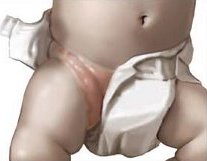 Most parents have heard about the dangers of BPA in infant bottles, and as such, stores usually sell BPA-free options. However, there are other dangers that parents do not yet know about.
Most parents have heard about the dangers of BPA in infant bottles, and as such, stores usually sell BPA-free options. However, there are other dangers that parents do not yet know about.
Disposable diapers pose a health risk to children. We have previously reported on sanitary pads and tampons causing endometriosis through dioxin exposure. Dioxins are a byproduct of chlorine, which is used during the bleaching process. Dioxins accumulate in the body throughout the lifetime of victims. Dioxin exposure as a child will impede the immune system of the individual forever. It means that they will never be as strong as they should have been. Dioxins are responsible for a range of reproductive and developmental problems, damaging the immune system, along with causing major hormonal imbalances and cancer. Many infants are now exposed to dioxins 24 hours a day, and yet society wonders why girls are beginning puberty younger than ever, and hormonal disorders are becoming increasingly common in children.
Unfortunately, dioxin is not the only issue with disposable diapers. Sodium Polyacrylate is an absorbent gel that is responsible for absorbing moisture inside the diaper. It was once present in tampons, but was removed for causing Toxic Shock Syndrome. Sodium polyacrylate has been implicated as a contributing factor of staph infections. It is a skin irritant, because it is able to absorb all of the oils and moisture from the skin, yielding a drying effect. It is no surprise, then, that problems like diaper rash are almost non-existent for babies having cloth diapers. The effects of topical exposure to sodium polyacrylate have only been minimally studied, so we do not yet know what damage it is doing. For the interest of our children, it is wise to err on the side of caution.
There are a variety of different dying agents used in diapers, ranging from indicators informing the parent of wetness, to colored patterns for improved appearances. Infants are showing allergic reactions to these diapers, and parents of these children are typically unable to identify the diapers as the cause. It is not uncommon for steroid creams to be used to treat these allergic reactions, with neither the doctor nor parent suspecting involvement by chemical dyes.
We strongly recommend that people look into the possibility of using cloth diapers, or at the very least, purchase unbleached, dye-free disposable diapers at a specialty or health food store. The health of our children is worth the minor inconvenience.
Related Articles
Sanitary Tampons and Pads: How Their Dioxins Are Leading To The Endometriosis Epidemic
